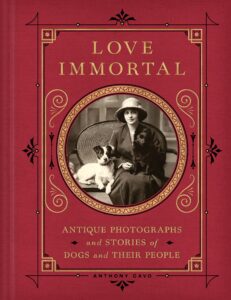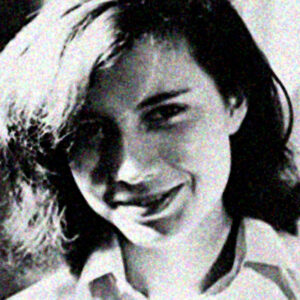Several years ago, while cataloguing the thousands of photographs in my collection of antique images, I found that I had hundreds of photographs of people with their dogs. While intrigued, I was not surprised that my love for dogs seemed to have become integrated with my passion for antique photographs, if even on a subconscious level.
Animals, especially dogs, had always been part of my family. Around the time I was eleven years old we had a rescue border collie who became impregnated by a stray dog who jumped our fence. She was less than a year old at the time and eventually delivered a litter of ten pups. During their birth, my mother enlisted our help in the delivery. Many of the pups were born still in their amniotic sacs; my mother showed me and my siblings how to open the sacs, clean their nostrils, and blow in their faces. We suctioned their airways with a turkey baster and even performed artificial respiration on two who were not breathing.
It is difficult to recall a time in my life when I was not involved with dogs or antiques, and especially antique photographs. My mother, a nurse by profession, became enamored with antiques in the early 1960s during our vacations in Pennsylvania. My father had a printing company in Manhattan and only a passing interest in antiques, but he enjoyed traveling with my mom to little towns in upstate New York, Connecticut, and especially to rural Pennsylvania on her quests for the rare and unusual.
I often accompanied my parents on their drives to Pennsylvania, to visit Ann, or “Ann the Duck Lady,” as I knew her, who operated a duck farm and an antique business out of a group of barns on her property. I was fascinated by the way hundreds of ducks appeared to move as one unit, a white wave breaking over the landscape, and even more fascinated by the treasures heaped chaotically within the barns. One day in 1963, among the piles of horsehair-stuffed Victorian chairs, marble-topped furniture, pier mirrors, and primitive furniture, I found a wooden box, its exterior stenciled in black: “From G. Cramer Dry Plate Co., St. Louis, MO.”
Dogs had been important in our home, but I never realized or even considered they might have been as important in the homes and lives of people who lived during the nineteenth century.I moved the box to a hazy patch of sunlight that entered the barn through a dirty, cracked window alive with fluttering cobwebs and opened it to find hundreds of people dressed like the people in my school history books. Some of the men looked like Abraham Lincoln, and all the women wore big gowns. By the time I finished digging through the box and examining every image, I was hooked, a photoholic; I had to have them. I wanted them all, but, as a kid, I had only enough money to buy a few. I carefully selected and paid for my photos, then went out to the barnyard to examine them in full sunlight.
My excitement at discovering these images and my keen interest in them did not escape my parents’ attention. They soon joined me as I extracted each photo and conveyed to them what I had learned about them from Ann—that we were looking into the faces of people who lived more than one hundred years before. That evening, when we arrived home, my parents surprised me with the wooden box and its mysterious contents. I spread the photos out on our dining room table and began to examine each one with a magnifying glass, calling out to my parents and siblings each time I found something interesting.
Finally, my older sister, who was the self-appointed spokesperson for us six children, seemed to sum up my siblings’ disinterest by asking, “Why are you collecting dead people, why can’t you collect baseball cards like a normal kid?” And so began a lifetime of collecting photographs. I still have that box and all the photographs it held.
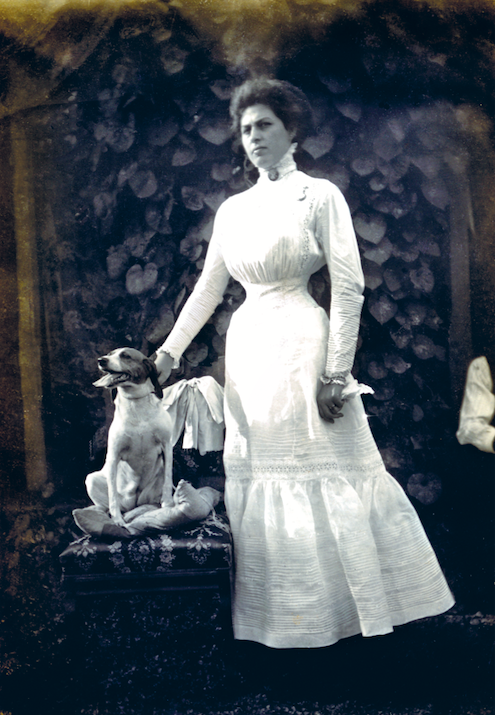
While other kids spent their weekends attending sporting events, going to the movies, visiting the beach, or simply hanging out, I sold antiques with my parents at the 26th Street Flea Market in Manhattan. My main objective at these flea markets was to make money and buy more photographs. While searching the vendors’ booths for photographs, other types of antiques began to interest me.
I bought a belt from a Civil War uniform, then Civil War–era newspapers. I also discovered a seventeenth-century book in a calfskin cover, a small bronze statue of a boy carrying a basket on his back, and an inkwell in the form of a boy with a fishing rod. My interest in antiques gradually expanded to include anything intriguing that was in my price range. Shortly after graduating from high school, I attended the Reisch College of Auctioneering in Mason City, Iowa. Upon my graduation from Reisch, I secured a job in a Manhattan gallery as a buyer, consignor, and auctioneer.
My mother, who was also an auctioneer, had an antique shop in Ridgewood, New Jersey, during the 1970s and another along Connecticut’s Antique Trail in Woodbury during the 1990s, which she kept well stocked with antiques from her two-story warehouse. On our never-ending hunt for antiques I have been in hundreds of attics, basements, barns, crawl spaces, defunct factories, and lopsided buildings, as well as several funeral parlors and even a caretaker’s cottage on cemetery grounds, all the while expanding my photo collection. It was on these jaunts that we acquired our pug, Winston, and schnauzer, Schatzi. Winston was destined to be put down because his owner was moving and he had outlived his usefulness as a stud. We took Winston home, along with an eighteenth-century Chippendale chest of drawers. He is long gone, but I still have that chest of drawers—a constant reminder of him.
During the first twenty years of photography, most people were not able to afford the cost of a portrait of themselves, let alone one of a dog.While buying antiques at another estate where the owner had died, we heard whimpering from the direction of the basement. The executor of the estate explained that in addition to the house and furniture, the owner left behind a dog who no one wanted. My mother promptly went into the dark cellar and returned with a frightened, undernourished schnauzer named Schatzi, whom we took home with us. In fact, in our search for antiques, we acquired many abandoned animals, including Caesar, one of our parrots. No Pet Left Behind.
At one point we had several rescue dogs: a poodle, a pug, and a schnauzer with her five pups. We also had a miniature Alpine goat, two barn cats, two rescued Amazon parrots, a pair of mourning doves, a Nanday Conure with one leg, and a rescued blue goose who had been injured in the wild and was no longer able to fly.
Dogs had been important in our home, but I never realized or even considered they might have been as important in the homes and lives of people who lived during the nineteenth century. I always assumed that during that time dogs were treated like, well, dogs. I imagined that they lived in doghouses and were treated much like any other animal. I never supposed, in the harsh conditions of that time, that a dog could have been as loved and treated as a true companion; the concept and pictorial evidence were intriguing.
I wasn’t far off, actually: Throughout most of history, the relationship between dogs and humans was primarily based on the dog’s usefulness to its owner. The notion of breed was not so important to the average person as the type of dog. Dogs were classified as hunters, ratters, herders, guardians, and even saviors. Many of these dogs had distinct, identifiable characteristics and were easily recognizable as a “ratter” or “herder,” but if a dog was good at their job, their looks were not especially important—then came the Victorians.
Dogs had been bred to perform certain tasks like hunting, herding, and pointing. For the first time, they were also bred for beauty and companionship.The Victorians applied knowledge about breeding livestock to breeding dogs. Dogs had been bred to perform certain tasks like hunting, herding, and pointing. For the first time, they were also bred for beauty and companionship. This breeding gave rise to the many varieties of dog breeds existing today.
As I cataloged my collection, I began showing the dog and people images to my family and friends who were initially fascinated, but after a while began to hide, feign illness, or take sudden vacations. I was left with no other choice but to share these images with the rest of the world in book form.
In the pages of Love Immortal are images of dogs and their humans from twenty-four countries and ranging from the 1840s to the 1940s. These captivating and engaging photographs depict the affinity and bond that have existed between dogs and humans for thousands of years but had never been accurately preserved until the advent of photography. A March 2018 article in the Journal of Anthropological Archaeology reported that recent archaeological discoveries in northwestern Saudi Arabia uncovered depictions of domesticated dogs and their human partners from about 7000 to 8000 BCE in what may be the first visual documentation of the human–dog bond, but true-to-life images portraying that connection weren’t available until the daguerreotype was made available to the public at large in 1839.
Named after French panorama painter and inventor Louis-Jacques-Mandé Daguerre, the daguerreotype is a photographic technique developed as a result of collaborative work in the early 1830s between Daguerre and Joseph-Nicéphore Niépce, a scientifically minded man who experimented with image-making at his home in Chalon-sur-Saône. Niépce is credited with producing the first permanent photographic image, or at least what is thought to be the world’s oldest surviving one—a heliograph (sun drawing) of the view from a window at his family home in 1826.
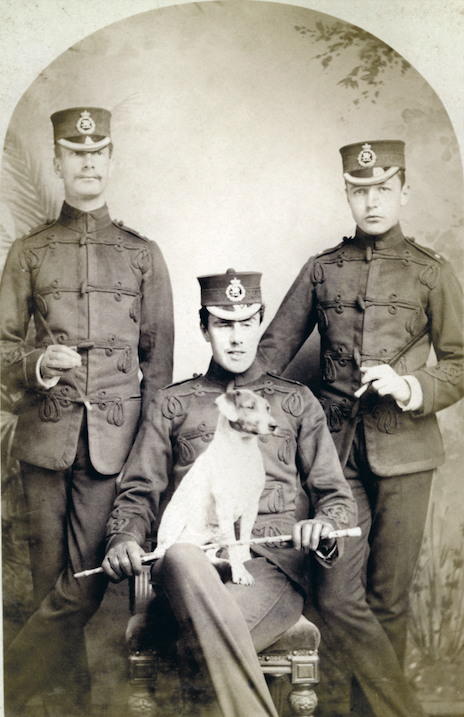
After Niépce’s sudden death in 1833, Daguerre kept on with his research, which led to the invention of the daguerreotype process, which in turn reduced exposure time enormously. By 1840, having a photographic portrait made became more affordable and thus available to more people. Capturing an image of a human alone was both a process and a commitment during photography’s first twenty years, so it is a testimony to the human–dog bond that owners included their pets in the process of having their “picture made,” as it was called at the time.
Though unfathomable to most people today—who are accustomed to the cell phone camera technology that makes creating a great-looking image child’s play—in the mid-nineteenth century, having a photograph taken was an event, even a significant undertaking. People often had to visit a large city to locate a photographer, which could mean hours of travel. Once in the studio, the camera had to be set up, the client posed, and the photographic plate prepared, developed, and finished. The availability of ambient light was often the limiting factor as to whether a photo shoot proceeded or was even successful.
The amount of available sunlight, time, and preparation required for a photograph were not the only factors to consider, either. During the first twenty years of photography, most people were not able to afford the cost of a portrait of themselves, let alone one of a dog.
In those days, exposure times were critical to obtaining clear, true-to-life images. Exposure time depended on the time of day and the amount of sunlight. There were no artificial sources of light other than candles and oil lamps. Obtaining a clear image during the optimal hours of 11:00 a.m. to 1:00 p.m., even in bright sunlight, was a challenge that required the subject to remain still for anywhere between thirty and ninety seconds. Imagine expecting the average dog not to move for a minute and a half!
The people and dogs in these images are not strangers to us—they are any of us who has ever loved a dog.Any movement during this exposure time resulted in a blurred image—in fact, you may notice a few in this book. Consequently, the ability to obtain a clear image of a typical dog was a remarkable achievement and why many photographers waited for the dog to lie down. The proper alignment of all these mitigating circumstances and requirements is what makes images of people with their dogs in photography’s early days a unique and cherished rarity.
The daguerreotype process was the dominant form of photography in the 1840s. The ambrotype, an image produced on glass, was introduced in 1851. The ferrotype (tintype) was introduced in 1852. Daguerreotypes, ambrotypes, and ferrotypes—three of the earliest types of photographs—are all produced by direct positive photography and result in laterally reversed images. A direct positive photograph means that the image is produced directly on the photographic plate itself by exposing the plate to light. For daguerreotypes, the photographic plate is silver-coated copper; for ambrotypes, the plate is glass; and for ferrotypes, the plate is lacquered iron. The process of producing photographs by all three methods meant that plates had to be prepared while the client waited.
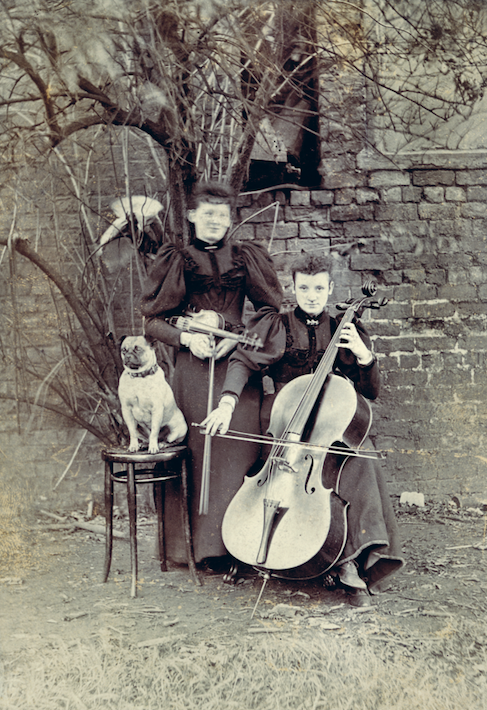
The daguerreotype and ambrotype prevailed until the late 1850s, when they were supplanted by the ferrotype (tintype) and albumen (paper) print. By the late 1850s, technological advancement decreased exposure time to mere seconds, reducing both the cost of making an image and the risk of creating a blurred one. The average person could easily afford the cost of a photograph, and for the first time, photographs were reproducible.
These photographs of people and their dogs are more than simple visual documents of our association with pets. In many of these images, both professional and amateur photographers have managed to catch a moment in time that displays the sense of intimacy that existed between a person and their dog. Other photos clearly depict the interaction between the photographer and the dog who, with wide eyes and tilted head, stares directly into the lens. The people and dogs in these images are not strangers to us—they are any of us who has ever loved a dog. In looking at these images we will recognize that special bond and feel a kinship with these long-gone partners.
_________________________________
Excerpted from Love Immortal. Copyright © 2022 by Anthony Cavo. Reprinted courtesy of Harper Design, an imprint of HarperCollins Publishers.


